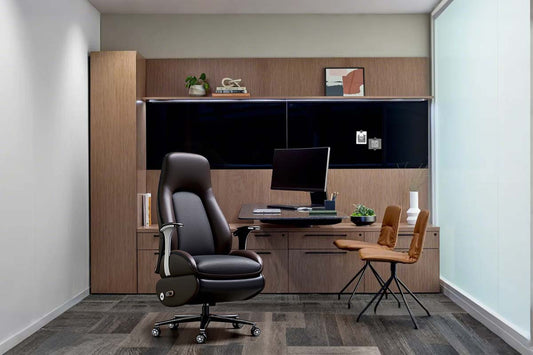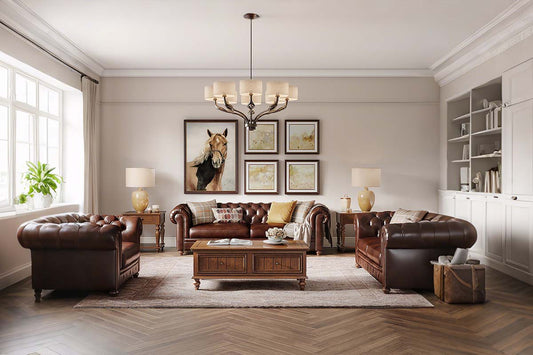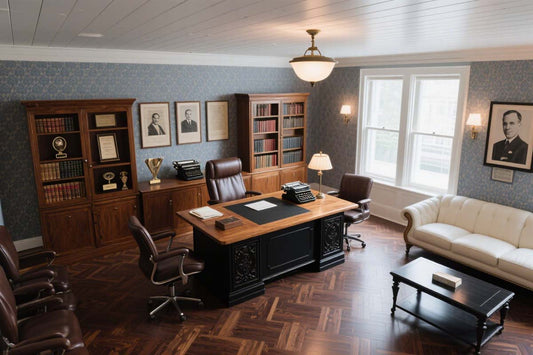
Leather Office Chairs: Are They Worth the Money in 2025?
Share
In modern business, decisions are shaped not just by strategy—but by atmosphere. From first impressions to long-term leadership cues, the quality of your office chair can communicate trust, stability, and authority long before you speak.
Far from being just another furnishing, a leather chair becomes an essential tool in the silent language of business. Below, we explore how high-quality leather seating plays a decisive role across multiple commercial dimensions—from client perception and leadership presence to cultural negotiation and brand signaling.
First impressions matter - your chair embodies your brand.

In high-stakes B2B environments, clients often form subconscious judgments about a company’s professionalism, values, and credibility within the first 30 seconds of entering a meeting room. According to Harvard Business Review, furniture quality is among the top non-verbal factors contributing to that impression.

It’s Not Just a Chair. It’s How You’re Remembered Elite law firm Skadden, Arps equips its NYC client rooms with custom leather conference chairs to evoke a tone of confidence and gravitas—professional but not cold.
Does experience and talent retention signify quality?
For executives and long-serving staff, a premium leather chair isn’t just ergonomic—it’s a mark of recognition. According to a Steelcase workplace survey, 65% of executives say the quality of their seating directly impacts focus, satisfaction, and performance.

A Chair That Holds More Than Just a Body When Microsoft redesigned its executive floors in Redmond, Italian leather high-back chairs were standard in every private office—supporting not just posture, but long-term productivity.
Is seating really just about comfort?
In boardrooms and negotiations, subtle differences in seating height, material, and placement communicate influence. A high-grade leather chair often signals “the final decision-maker,” helping visitors intuitively grasp the hierarchy—without anyone needing to say a word.

Behind Every Leather Chair, There’s a Way of Leading.At Morgan Stanley, the CEO and CFO use elevated leather chairs with extended backrests in board meetings, creating a visual cue of directional authority.
Are leather chairs a durable investment with tangible asset value?
Unlike synthetic or mass-market office chairs, high-end leather seating depreciates slowly and can retain resale value—sometimes even appreciating as collectibles. Brands like Herman Miller, Knoll, and Poltrona Frau have second-hand markets due to their craftsmanship and design legacy.
Take a Seat—And Take Control An IBM executive in New York has used the same leather chair for over 20 years—now maintained as part of the office’s asset register and executive succession planning.
How can leather be used as a non-verbal negotiation tool?
Seating styles are culturally coded. In Asia, high-backed leather chairs convey seniority and wisdom. In Western contexts, they imply authority and decision-making status. Strategic chair placement can shape perception across national lines.

Where You Sit Speaks Louder Than You Think. At the UN Office in Geneva, key negotiators sit in premium De Sede leather chairs, while delegates use smaller fabric ones—subtly reinforcing who sets the tone.
What does your chair say about your leadership style?
A leader’s choice of seating often reflects their leadership model. Stable, structure-driven leaders often choose classic leather chairs that suggest grounded authority. Agile or fast-paced leaders prefer lightweight, mobile seating for constant movement.

The Quiet Confidence of a Well-Chosen Chair. At Tesla, Elon Musk prefers barstools or standing meetings to signal informality and speed. In contrast, Warren Buffett’s Omaha office is anchored by a traditional leather armchair—symbolizing steady, long-term thinking.
What is Apple’s Leather Chair Philosophy all about?
Inside Apple Park, the executive offices feature leather seating by Herman Miller and Vitra—matching the brand’s minimalist but premium aesthetic. The chairs aren’t just functional—they reinforce Apple's design-led identity and obsession with cohesion.
Are leather chairs the anchors of legal legacy?

At Winston & Strawn, a 150-year-old law firm in Chicago, the boardroom still features mid-century leather chairs—identical in color and form. Their visible aging isn't wear—it’s heritage. These chairs quietly assert: “We’ve been doing this a long time.”
What is the impact of visual hierarchy in environmental psychology?
Skadden’s use of deep brown and wine-colored leather in its senior offices is more than aesthetic. The pairing with wood desks and classic art subtly reassures clients: this is a place where your case is taken seriously.

Why not exude confidence with the prestige of a leather patina?
A chair that develops wear over time—creases, polish, softened lines—often sends the most powerful message: “This leader is seasoned. This office doesn’t perform, it decides.” Such patina becomes a badge of continuity and trust.
A Leather Chair: More Than Just a Seat, It Speaks Volumes
Whether it’s earning trust in a pitch, showing restraint in a negotiation, or commanding attention in silence, a leather chair helps shape outcomes through presence, not volume.
In business, the room doesn’t always respond to the loudest voice. Sometimes, it turns to the one leaning back in a leather chair—thinking deeply, waiting patiently.
At Povimo, we design leather executive chairs that embody this quiet power—crafted for presence, not just posture. If you're looking for a chair that speaks before you do, feel free to explore our collection.
Sometimes, how you sit is how you're remembered.




